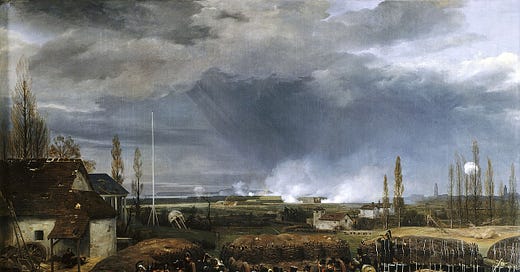“It is often our mightiest projects that most obviously betray our degree of insecurity,” explains Austerlitz, the protagonist of W.G. Sebald’s novel of the same name.
To wit: in Europe, the star-shaped fortresses of the 18th century were built in anticipation of advancing armies, only to undermine their effect by accentuating their weak points and expanding to keep pace with new enemies, urban sprawl, and the disadvantages of their mobile opposition. “The largest fortifications will naturally attract the largest enemy forces,” Austerlitz reasons. “The more you entrench yourself the more you must remain on the defensive.”
For all their brilliance, he says, the continental masters of military architecture never seemed to cotton on to the fundamental “wrong-headedness” of their behemoths. Instead, they “forged ahead…far and beyond any reasonable bounds.” Austerlitz muses that smaller buildings—like cottages and bothies—offer at least a semblance of peace to their beholder, but what of siegecraft’s vast and terrible edifice? He leaves us with this banger:
At the most we gaze at it in wonder, a kind of wonder which in itself is a form of dawning horror, for somehow we know by instinct that outsize buildings cast the shadow of their own destruction before them, and are designed form the first with an eye to their later existence as ruins.
It’s all too easy to compare Austerlitz’s fortresses and their inexorable growth with the cancer of capitalism. As they expand, militarizing every square inch of a territory along the way, they become the borders they ostensibly defend, increasing their mutual hardness, sharpness, and destructive capacity as they fluctuate and contort within and around each other.
This is as true now in the States as it was in Belgium a few hundred years ago: nearly 2 out of 3 of people living in America are within the 100-mile border zone in which USCIS, ICE, and US Customs and Border Protection are granted certain “powers without warrant” (the Fourth Amendment still affords citizens some protection from that, sort of). In his review of John Washington’s The Case for Open Borders, Jake Romm calls borders “hellgates”—but which side is hell on? The Harris presidential campaign, and the Democratic establishment it represents, has agreed with the Republicans that it’s on the other side; as Republicans radicalize on immigration, writes Daniel Denvir, the “Democratic elites chase after them.” In contradiction to their Trump-era lip service, the Democrats’ “‘normal’ position on immigration moves ever rightward.”
But you and I know, of course, that the need to keep “them” out is propaganda designed to conceal the diminishing returns of citizenship here in the imperial core. The chickens have always roosted, but those birds are really going for it in 2024. As Romm writes, “The preservation of borders in the face of climate catastrophe, global conflict, and regular economic crises will require ever greater internal and external violence.” Beyond America’s borders, famine has been declared in Darfur, melting glaciers have forced Italy and Switzerland to redraw their borders, and greenhouse emissions from Israel’s genocide (now spilling over, again, into Lebanon) rivals those of dozens of other country’s annual outputs combined; within them, we beg our government to save us from tropical storms, chemical spills, and pandemics, and its response is to send yet more money to murder Palestinians.
Is our border a fortress? If these are still separate entities, what’s to stop their eventual convergence? Or has it already happened?
Fundraisers for survivors of Hurricane Helene are here. Send me your receipt of donation and I’ll send you 1 free month of subscriber-only content.
Thank you for reading and sharing my weekly newsletter. You can also support me by buying my book. Find me on Twitter and Instagram.




